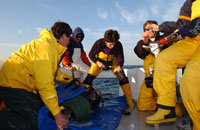The 2008 ICCAT meeting concluded last week in Marrakech, Morocco. The media had been buzzing about bluefin tuna in the weeks leading up to the meeting, particularly in regards to putting an end to the egregious level of illegal overfishing in the Mediterranean Sea. The European Union (EU), the most flagrant abuser of current regulations, said that “time is running out to save the bluefin tuna stock from collapse” and committed to “champion bold and decisive measures” at the meeting. Several nations, including Japan, proclaimed that without meaningful and resolute action by ICCAT, Atlantic bluefin tuna management would be transferred to CITES, the body that regulates international trade of endangered species – and a highly feared adversary of anyone involved in commercial exploitation of an animal or plant species.
Despite all the hype, by the time the dust settled in Marrakech, it was business as usual for ICCAT. The EU was up to its typical antics, maintaining a veil of secrecy on its eastern bluefin proposal until the final days of the meeting. Despite calls ranging from a moratorium, as suggested by an external review panel commissioned by ICCAT, to a 15,000 metric ton (MT) quota, as recommended by ICCAT’s own scientists, the eastern quota was only reduced from 27,500 MT to 22,000 MT for 2009, with a further reduction to 18,500 by 2011. Equally problematic, ICCAT also failed to close the Mediterranean spawning ground for the months of May-July as urged by scientists but instead extended the existing closure by a measly 2 weeks. There is some hope that the new regulations will improve compliance, which, if true, will be more meaningful than any potential quota reduction given the current level of illegal fishing. However, given the fishery’s current operating climate, we’ll believe it when we see it.
The western Atlantic quota was reduced from 2100 MT to 1900 MT for 2009 and 1800 MT for 2008, a change in line with the scientific advice. Yet another ICCAT meeting where our fishermen will follow the science, even if it's a sacrifice, and those in the East will ignore it. As part of the negotiations, Canada was assured transfer of U.S. and Mexican unharvested quota, which will likely result in a comparable harvest level for Canada (and perhaps the entire western Atlantic given recent U.S. underharvests). In a positive development, rollover of underharvest will be capped at 10% by 2011; if a population is so depleted that the allowable take can not be harvested, it is dangerous to add that unused quota to the following year, further threatening the population. The most alarming provision of the new regulations potentially opens a loophole for Mexico to increase fishing mortality on bluefin on the Gulf of Mexico spawning grounds. We are already working to reduce mortality in U.S. waters of the Gulf; this is no time to launch a new fishery in the western bluefin’s most critical habitat.
The U.S. and other Atlantic fishing nations have until June 2009 to implement the new regulations. Hopefully the media and stakeholder groups will keep bluefin in the spotlight and demand accountability. Given the lack of progress, preparations for a CITES listing will undoubtedly proceed in parallel to efforts to implement and enforce the new measures.
The search for bluefin tuna is on! A team of scientists from Stanford University and other partner institutions is scouring waters in both the Atlantic and Pacific oceans. The goal - to place electronic tags in giant bluefin tuna to learn more about their migrations, behavior, and environmental preferences. Read about their adventures below...




1 comment:
Hi folks! Good post as usual. As a relative newcomer in the fight to save the Atlantic bluefin, I find it hard to identify which battles seem winnable. It seems that the ongoing battle with ICCAT and the EU seem the hardest. That said, closer to home here in the USA, closing the spawning grounds in the Gulf and further reducing the harvest of juveniles from any constituent (commercial or recreational) in the Western Atlantic seem more attainable. Is this an accurate viewpoint?
Post a Comment